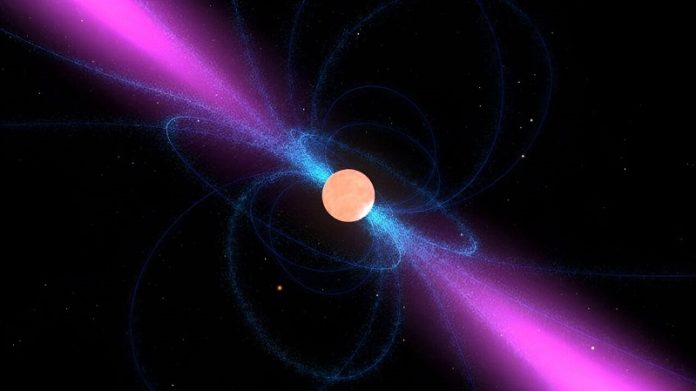
Astronomers are using pulsars, known as the universe’s “timekeepers,” to find clues about dark matter.
Pulsars are neutron stars that rotate and emit beams of radio waves, like a lighthouse.
These beams sweep through space at very regular intervals, making pulsars extremely accurate timekeepers.
Professor John LoSecco, an astronomer at the University of Notre Dame, presented his findings at the National Astronomy Meeting at the University of Hull.
He explained how scientists have developed precise methods to measure time. On Earth, we have atomic clocks, and in space, we have pulsars.
For over a century, scientists have known that gravity can slow down light, but they haven’t found many practical uses for this knowledge until now.
Professor LoSecco observed variations and delays in the timing of pulsar signals.
These delays suggested that the radio beams were traveling around an unseen mass between the pulsar and the telescope. He believes these hidden masses could be dark matter.
Professor LoSecco’s research focused on delays in the arrival times of radio pulses, which are usually accurate to nanoseconds. He studied data from the Parkes Pulsar Timing Array (PPTA2) survey, which collects precise measurements of pulse arrival times from seven different radio telescopes worldwide.
The observations showed that deviations in pulse arrival times due to dark matter have a specific pattern and size proportional to the mass of the dark matter. Light passing near dark matter slows down, creating a delay. A search of data from 65 “millisecond pulsars” revealed about a dozen instances that appeared to be interactions with dark matter.
Professor LoSecco explained that the Earth, the Sun, the pulsar, and even dark matter are all moving. By observing changes in the arrival times of pulses, scientists can determine the distance between the mass and the line of sight to the pulsar.
One significant finding showed a distortion of about 20% of the Sun’s mass, suggesting the presence of a potential dark matter object. These observations have a resolution of nanoseconds, which is 10,000 times smaller than a microsecond.
This research not only sheds light on the nature and distribution of dark matter in the Milky Way but also improves the accuracy of pulsar timing data. By identifying and removing dark matter objects from the data, scientists can eliminate noise during other searches for gravitational waves.
“The true nature of dark matter is a mystery,” said Professor LoSecco. “This research helps us understand more about dark matter and its distribution in our galaxy, and it also enhances the precision of our pulsar data.”



